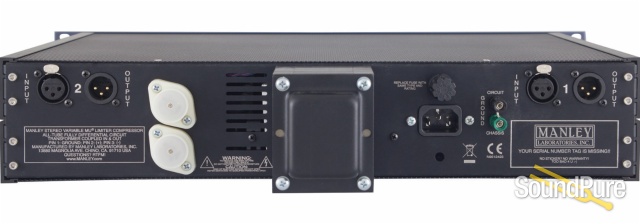Manley Stereo Variable Mu® Limiter Compressor
- Signal Chain

The Variable Mu Limiter Compressor is the GLUE that holds the mix together while crystallizing it into a professional, final product. All-tube, all transformer, an all-American legend. High Pass Side Chain mod now comes standard.
$7,399.00
The Mastering Version of the Variable Mu® Limiter Compressor incorporating detented and logable steps built with 1% metal film resistors on sealed gold-contact Grayhill switches is available. NO, they will not mod a "normal" unit to the Mastering Version. The Mastering Version of the Variable Mu Limiter Compressor uses expensive Greyhill rotary switches with gold contacts where conductive plastic pots were used. The steps are determined with a large number of 1% precision metal film 1/2 watt resistors. The best conductive plastic pots only have 10% or 20% tolerance. The ten fold improvement in precision helps a great deal in left-right matching. There is a subtle audible improvement with stepped switches as well. Audiophile HI-FI often uses that technique to wring the last drop of performance out of a preamplifier. And I bet you wanted stepped switches mostly for resets.
The INPUT LEVEL is a five position switch with a generic optimum setting of “0” in the 12:00 position. Each step in either direction is 2 dB. For reference, Unity Gain is "0".
The OUTPUT Attenuators are in half dB steps. Reference Unity is -11.5 or fully counter-clockwise. You might think of these as "gain makeup". They are marked technically, in that “0” or fully clockwise has zero attenuation in the circuit. The tube circuit actually has 15.5 dB of gain. The Input attenuator at "0" removes 4 dB and the Output attenuator removes the last 11.5 producing "unity". With a little compression the "gain make-up" available with the Output Attenuator is very handy.
The Threshold is in half dB steps calibrated to LIMIT mode. In Compress the steps are approximately 1/4 dB. There are 24 steps so LIMIT gets a 12 dB range and Compress has a 6 dB range of adjustment. In some cases it is common to use the Input Attenuator to find a good starting point. Some Mastering engineers find using the combination of Input, Output and Threshold to achieve a little different "drive". Another good reason for stepped gains.
MID/SIDE (a.k.a. Vertical/Lateral, or Sum/Difference)
This modification opens the door to stereo encoding and decoding as well as exciting image enhancement processing capabilities. For instance, setting to compress only the in-phase information allows the augmentation of the stereo image as the out-of-phase content is left untouched. Or, conversely, if you need a "more-mono" mix for broadcast, or vinyl-cutting for instance, you can set it to kill off more of the out-of-phase info which leaves more in-phase material in the final result. Read more about the MS Mod on page 12 of the Owner's Manual.
In order to add both M-S and the HP SC mods, we move the power switch to the rear panel and install both channels' HP SC switch to the center hole where the power switch was. The M-S switches then flank this switch.

The MANLEY brand has been around since the late 1980's. Manley's first commercially available products were upper echelon high-fidelity vacuum tube amplifiers and preamplifiers constructed at the old Vacuum Tube Logic of America factory.
In this history lesson, we'd like to direct special focus on our people at Manley Labs. The people whose years of dedication, service, and expertise bring you people, our customers, these products. It's all about the people...
On January 30, 1989, a 20 year old EveAnna on sabbatical from her studies at Columbia University met the crew and was hired on to the production team. Baltazar Hernandez, already with two years experience, taught her how to solder in those first few days. It was in 1989 that the first Manley professional products were developed, starting with the original 1u Reference 60dB Microphone Preamplifier and soon followed by our Manley Enhanced Pultec and Mid Frequency Equalizers. Baltazar and EveAnna, busy building gear, were soon joined by Saulo and Ramiro. Just next door, Elias was employed by a printed circuit board maker later brought into the Manley Labs fold when in 1993, Manley Laboratories, Inc. became a separate entity apart from VTL. The new Manley Labs factory at 13880 Magnolia Ave. in beautiful and bovine Chino, California was outfitted to house the Manley HiFi and Pro Studio manufacturing as well as the Langevin production lines, our newly acquired machine shop, and printed circuit board facilities.
The Attack Time has been slightly extended in both directions compared to a regular Variable Mu and divided into 11 steps.
The Recovery 5 position switch is exactly the same as a regular Variable Mu.
The switches specifically are like this:
Input: -4 to +4 in 2 dB steps
Output: -11 to 0 in 1/2 dB steps (24 detents)
Threshold: -11 to +1 in 1/2 dB steps LIMIT(24 detents) and 24 x 1/4 dB steps in COMPRESS
Attack: 11 positions CW (fast) 15mS, 20, 25, 30, 35, 40, 50, 60, 70, 80, 90mS (slow) CCW
Release: 5 positions CW (fast) 200mS, 400mS, 600mS, 4S, 8 Seconds (slow) CCW
 Payments as low as $168/mo.
Payments as low as $168/mo.